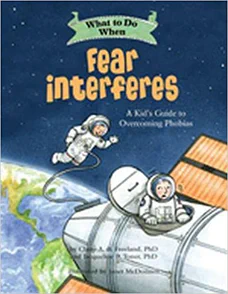What To Do When Fear Interferes
A Kid’s Guide to Overcoming Phobias
Written by Claire A. B. Freeland, Ph.D. and Jacqueline B. Toner, Ph.D.
Illustrated by Janet McDonnell
88 pages
•
Published 2019 (Magination Press)

Recommended Age Range: 1st grade through 5th grade.
Publisher's Summary:
Lots of kids are a little afraid of some things, like heights or spiders. But some kids are so afraid that it stops them from having fun. Does this sound like you? If your fear is getting in the way of everyday activities, this book is for you! What to Do When Fear Interferes guides children and their parents through overcoming phobias using strategies and techniques based on cognitive-behavioral principles.

Dr. Annie's Takeaways
Recommended for: This workbook is a must-read for any child and their caregiver who are looking for relief from phobia(s). It’s an interactive book that teaches children gold-standard cognitive-behavioral strategies
to reduce their fears, and it’s applicable to any and all phobias, including fears related to animals (e.g., dogs, spiders, bees, sharks), nature (e.g., heights, thunderstorms), injuries (e.g., blood, shots), small spaces (e.g., airplanes, elevators), and/or anything else (e.g., clowns, balloons, vomiting).
Would a child like it? A child who is sick of a phobia getting in the way for them will likely feel empowered by this book. It’s not a story, but it’s written in a relatively enjoyable, child-friendly way.
Tone: Informative, encouraging
Story Quality: This workbook uses a metaphor of an astronaut working towards being ready to fly into space by conquering their fears little-by-little and by learning to respond appropriately to alarms and warning signals that happen on spaceships. It’s a pretty effective metaphor that successful destigmatizes phobias and motivates kids to take steps toward facing their own fears. The explanations in the workbook are clear and child-friendly, and the interactive exercises are useful and sometimes fun.
Illustrations: Black-and-white watercolor illustrations that supplement the text. Most pages have an illustration, but some pages are dominated by text.
Representation: Many different children are portrayed in the illustrations throughout the text (i.e., children with different skin tones, hair, and genders). An example or two includes mention of Mom or of Dad.
Psychological Practices: Psychoeducation about anxiety and phobias, including the difference between real emergencies and false alarms; how phobias interfere with kids’ lives; exposure
and “getting used to things”; creation of a fear hierarchy; problem solving obstacles to exposure, such as reassuring seeking and feeling overwhelmed; helpful self-talk versus unhelpful self-talk; and relaxation strategies (diaphragmatic breathing, visualization, exercise, creating, spending time with friends).
Concerns: None
